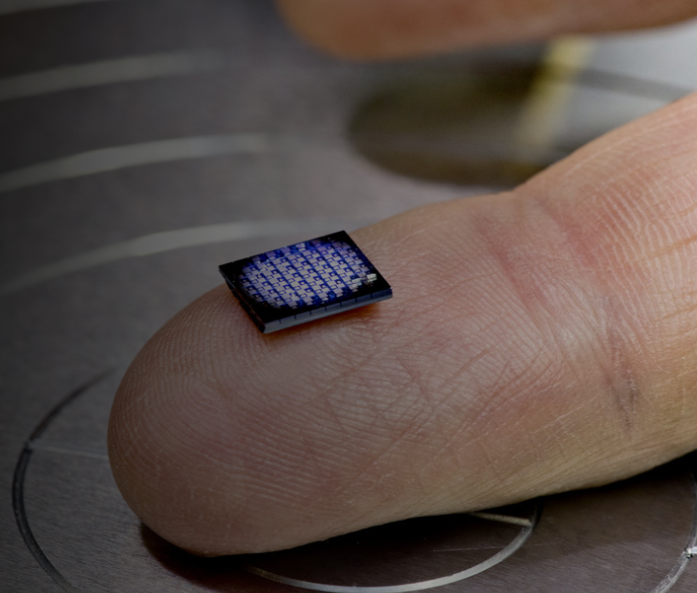By Jean-Jacques DeLisle, contributing writer
IBM released something huge for blockchains but extravagantly small in size. The company’s new computer, which is the smallest in the world, has a footprint of only 1 x 1 mm. That is astonishingly small for a computer, considering that it’s smaller than a grain of salt. The computers contain a complete system-on-a-chip (SoC) with a processor, memory, storage, and a communication module and can analyze, communicate, and even act on data. Used with blockchain technology with added crypto-anchors, this new computer may revolutionize the way that shipping companies track freight to fight fraud.

This ordinary-looking chip is actually an array of 64 SoCs, each containing a photocell and LED array for optical communications, SRAM, and IBM’s salt-grain-sized processor. Image source: IBM.
This advancement in technology promises to offer a solution to a problem that has been plaguing the shipping industry since its insurrection: counterfeit products. When you think of counterfeit items being sold, you might imagine a fake antique or watch trying to be sold by a street vendor or a ripoff of a famous painting being sold as an original, but the problem can also be much closer to home. Medications are commonly stolen and replaced with placebos, which can lead to serious problems for those who count on those medications to survive.
Such theft-and-replace is surprisingly easy. With millions of items being shipped all over the world every day, it is nearly impossible to keep track of them all. Some freight can travel through dozens of countries before reaching its destination, and at any point, criminals could potentially swap a product for something else in its place.
The new tiny computer IBM has created may be able to solve the problem of counterfeiting through the application of blockchain technology. Originally created for use with cryptocurrency, blockchain technology is a distributed electronic ledger that records all interactions that take place involving a particular transaction, providing a secure copy to all stakeholders in the transaction that includes links to records of prior transactions. Blockchains record every time a bitcoin changes hands, for instance, with the links providing a history of its ownership. The secure, distributed ledger ensures that no one can falsify a transaction without detection.
A second element of the counterfeiting solution involves crypto-anchors, which extend blockchain’s value into the physical realm. A crypto-anchor is a tamper-proof digital “fingerprint” embedded into a device that provides it with a unique identity. Coupled with blockchain, the presence of a crypto-anchor allows secure tracking of the object’s ownership as it changes hands. Counterfeits then become simple to detect because they will not have a valid blockchain associated with them.
IBM aims at applying its tiny computers as crypto-anchors to this method of blockchain-based object tracking. By embedding the computers, each encoded with a unique, encrypted identity, into goods intended to be shipped, the retailers or customers who buy those products can then use blockchain to track products back through the places that the items have been — even in real time. At each shipping stage, a handler would use the light-powered computer’s optical communications to interact with the device and register its presence as well as create a blockchain entry. That information would go to a tracking computer in the cloud as well as be stored in the computer. This onboard record of events, if compared to the cloud copy, could allow people to determine beyond the shadow of a doubt if a product is authentic or not. Would-be counterfeiters, however, are possessed with no such luck. And should someone try to re-sell stolen goods, a scan could immediately reveal that the goods are not where they should be, alert the authorities, and lead straight to the culprits in real time.
Forgery and counterfeit goods cost the global economy up to $600 billion a year, so I suppose it is worth it for IBM to invest its time and money into the production of these minuscule computers. With an expected price tag of fewer than 10 cents, you can bet that these tiny chips will make a big splash in the world’s transportation of goods.
Advertisement
Learn more about Electronic Products Magazine





